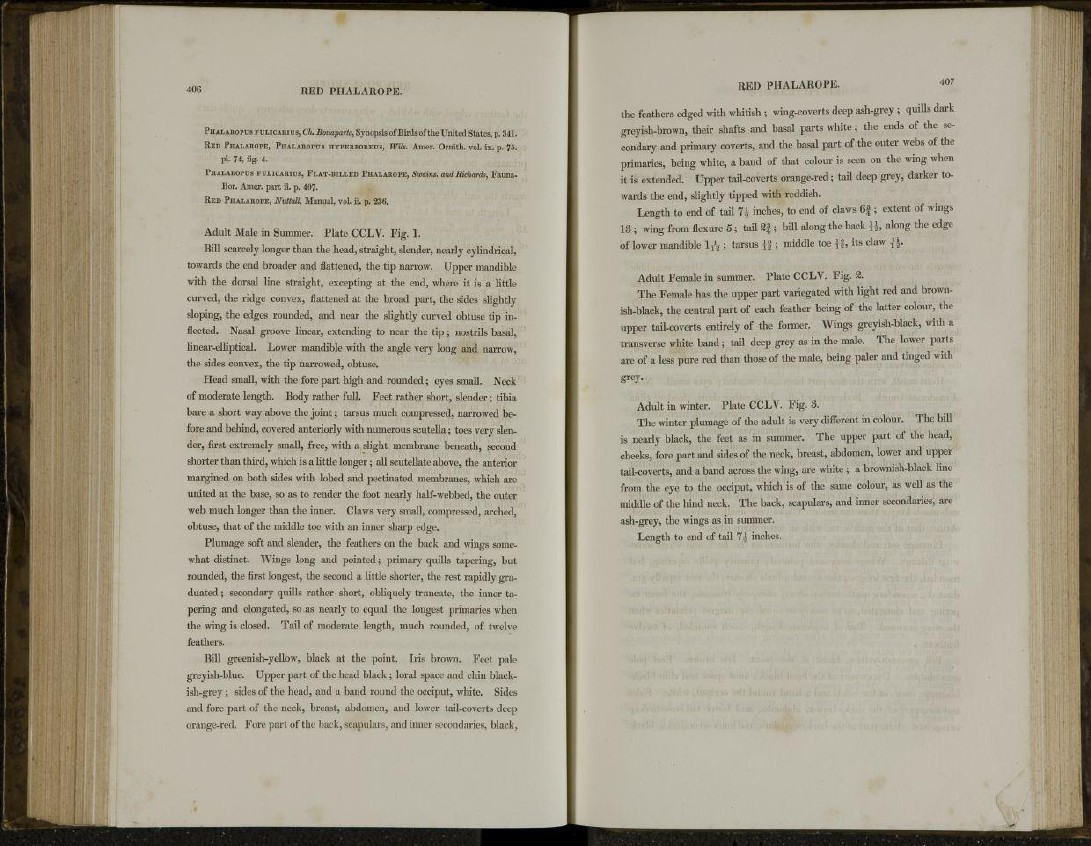
406 RED PHALAROPE.
PHALAROPUS FULICARIUS, Ch. Bonaparte, Synopsis of Birds of the United States, p. 341.
RED PHALAROPE, PHALAROPUS HYPERBOREUS, Wits. Amer. Ornith. vol. ix. p. 75.
pi. 74, fig. 4.
PHALAROPUS FULICARIUS, FEAT-BILLED PHALAROPE, Swains, and Richards, Fauna-
Bor. Amer. part ii. p. 407.
RED PHALAROPE, Nuttall, Manual, vol. ii. p. 236.
Adult Male in Summer. Plate CCLV. Fig. 1.
Bill scarcely longer than the head, straight, slender, nearly cylindrical,
towards the end broader and flattened, the tip narrow. Upper mandible
with the dorsal line straight, excepting at the end, where it is a little
curved, the ridge convex, flattened at the broad part, the sides slightly
sloping, the edges rounded, and near the slightly curved obtuse tip inflected.
Nasal groove linear, extending to near the tip; nostrils basal,
linear-elliptical. Lower mandible with the angle very long and narrow,
the sides convex, the tip narrowed, obtuse.
Head small, with the fore part high and rounded; eyes small. Neck
of moderate length. Body rather full. Feet rather short, slender; tibia
bare a short way above the joint; tarsus much compressed, narrowed before
and behind, covered anteriorly with numerous scutella; toes very slender,
first extremely small, free, with a slight membrane beneath, second
shorter than third, which is a little longer; all scutellate above, the anterior
margined on both sides with lobed and pectinated membranes, which are
united at the base, so as to render the foot nearly half-webbed, the outer
web much longer than the inner. Claws very small, compressed, arched,
obtuse, that of the middle toe with an inner sharp edge.
Plumage soft and slender, the feathers on the back and wings somewhat
distinct. Wings long and pointed; primary quills tapering, but
rounded, the first longest, the second a little shorter, the rest rapidly graduated
; secondary quills rather short, obliquely truncate, the inner tapering
and elongated, so as nearly to equal the longest primaries when
the wing is closed. Tail of moderate length, much rounded, of twelve
feathers.
Bill greenish-yellow, black at the point. Iris brown. Feet pale
greyish-blue. Upper part of the head black; loral space and chin blackish
grey ; sides of the head, and a band round the occiput, white. Sides
and fore part of the neck, breast, abdomen, and lower tail-coverts deep
orange-red. Fore part of the back, scapulars, and inner secondaries, black,
RED PHALAROPE. 407
the feathers edged with whitish ; wing-coverts deep ash-grey ; quills dark
greyish-brown, their shafts and basal parts white; the ends of the secondary
and primary coverts, and the basal part of the outer webs of the
primaries, being white, a band of that colour is seen on the wing when
it is extended. Upper tail-coverts orange-red; tail deep grey, darker towards
the end, slightly tipped with reddish.
Length to end of tail 7^ inches, to end of claws 6 | ; extent of wings
13 ; wing from flexure 5 ; tail 2f; bill along the back along the edge
of lower mandible 1T*S ; tarsus ; middle toe i§, its claw ^ j .
Adult Female in summer. Plate CCLV. Fig. %
The Female has the upper part variegated with light red and brownish
black, the central part of each feather being of the latter colour, the
upper tail-coverts entirely of the former. Wings greyish-black, with a
transverse white band; tail deep grey as in the male. The lower parts
are of a less pure red than those of the male, being paler and tinged with
grey.
Adult in winter. Plate CCLV. Fig. 3.
The winter plumage of the adult is very different in colour. The bill
is nearly black, the feet as in summer. The upper part of the head,
cheeks, fore part and sides of the neck, breast, abdomen, lower and upper
tail-coverts, and a band across the wing, are white ; a brownish-black line
from the eye to the occiput, which is of the same colour, as well as the
middle of the hind neck. The back, scapulars, and inner secondaries, are
ash-grey, the wings as in summer.
Length to end of tail 7 | inches.